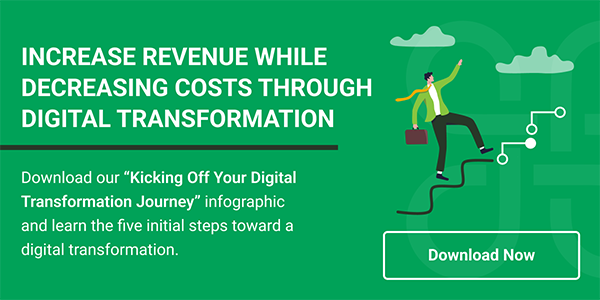One of the key components of success for any business is its ability to adapt and be resilient. The past few years of turmoil and volatility have proved that point further.
Digital transformation is the vehicle to ensure an enterprise can weather whatever comes next. Committing to digital transformation also means future-proofing your business. The journey of digital transformation is continuous and complex, but the long-term value sets up your organization for future growth and stamina.
What Is Digital Transformation, and What Are Its Goals?
Digital transformation means different things to each business. In general, it means driving change to meet efficiency, value, and innovation goals with technology, processes, and methodologies. Digital transformation creates a dynamic environment with many stakeholders and moving pieces involved.
Digital transformation goals vary depending on the unique business, its industry, customers, and technology needs. The most pertinent objective is to create new business processes or modify existing ones to deliver a better outcome. Digital transformation is an enterprise-wide initiative to streamline workflows, boost productivity, reduce errors, improve customer experiences, and fuel growth.
Ultimately, it’s about moving your business forward and modernizing how you do things. How this plays out for your organization will depend on many factors, but it’s a powerful tool in future-proofing.
What Does Future-Proofing Involve, and Why Does It Matter?
Future-proofing is the process of anticipating and preparing for future change and challenges in a way that drives long-term success. It means progressing a company by baking in the ability to adapt and evolve to meet customer and employee needs.
When companies fail to do this, they hit major barriers. It’s not that organizations don’t have foresight or aren’t considering what will come. It’s simply easy to get distracted by present issues and fires and overlook planning for tomorrow.
Case Studies in the Failure to Future-Proof
Businesses often miscalculate critical future needs, whether because of blind spots or unprecedented events. Southwest Airlines’ massive flight cancellations and havoc in December of 2022 serve as a case study in both. The initial catalyst was an unexpected massive winter storm, but Southwest was unable to adapt quickly compared to other airlines.
A point-to-point routing network, combined with staffing shortages, predictably delayed Southwest’s recovery as other airlines resumed traffic. Yet the most significant factor that prevented the airline from adapting as the storm cleared was a dated computer system, which was unable to efficiently reassign crews to flights.
Southwest Airlines’ inability to future-proof its operational systems both for internal communications and customer support were the root cause of its failure to adapt during this critical moment. These shortcomings cost the company significantly at the time and may have lost loyal customers for life. It once had a strong reputation with passengers and was often atop the list of best airlines, but now, Southwest is suffering reputational harm from which it may never fully recover.
Since the incident, the company has publicly announced that it’s investing in operations and tactical action plans to avoid a similar failure in the future. Specifically, it is upgrading crew scheduling and customer communications systems—but what if it had proactively upgraded these systems as part of a digital transformation plan before the December 2022 incident occurred? Last year’s debacle likely would have played out much differently and resulted in far less reputational harm to the brand.
The Consequences of Failing to Future-Proof
Many other companies serve as case studies for failure to future-proof and the disastrous results that followed. Blockbuster failed to embrace the potential in streaming, for instance. Once a retail leader, Sears didn’t evolve based on customer preferences and changing shopping behaviors.
These examples illustrate the need to keep pace with evolving consumer needs and technological developments. Stagnation leaves your organization vulnerable to competitors that are waiting to usurp market share. It can also impact the customer experience, causing more churn. Without moving to the next technological horizon, you even risk missing out on improved operational efficiency and more meaningful work for employees.
Striving Toward Future-Proofing Requires a Defined Strategy
Your enterprise will need a documented and adaptable strategy to achieve digital transformation goals that contribute to future-proofing. Within this plan, you’ll need to evaluate operations, understand the necessary resources, and make automation decisions.
The following recommended steps will help you future-proof your organization:
1. Establish a Transformation Road Map
Without a road map, the people in your organization will be lost. Create a plan for how individuals’ roles will progress through transformation and what meaningful work will look like as technology scales.
2. Build a Center of Excellence (CoE)
A Center of Excellence (CoE) is a group of internal leaders who provide the vision, direction, and governance for your automation program. This team creates stability around automation initiatives by tying them to business objectives, digital transformation, and future-proofing. A CoE ensures oversight, strategic investment, ease in scaling, and the ability to introduce the change to users more effectively.
3. Use the Right Tools to Assess Your Current Situation
Assess your technology infrastructure, processes, and customer experiences. For these initial evaluations, look for friction points and barriers impacting your operations. Tools like Process Mining provide an understanding of the true steps of a workflow from transactional data. This intelligence lets you plot your current state and plan for the future.
4. Identify Automation Opportunities and Strategies for Scaling Them
From your assessment, you’ll next define where you want to inject automation for the greatest value. You can consider Robotic Process Automation (RPA) for rules-based, repetitive tasks and technologies such as AI, Machine Learning, or Digital Process Automation for more complex processes. The nature of these automation programs may need to generate demand to build a pipeline, and many underestimate the time investment required.
5. Establish Goals and a Readiness Program Before Launch
Establish goals and expected outcomes before commencing digital transformation. Discern what you’re trying to accomplish so you can effectively determine which technologies will help.
Create a readiness program, chaired by your CoE, for employees to usher in change management. Consider how automation will impact them, and be communicative and transparent in how you introduce it to them. You’ll need their buy-in for adoption.
Challenges in Future-Proofing Business Via Digital Transformation
Future-proofing is good for business, enabling growth and adaptability. It’s not a linear path, however, and you’ll encounter challenges along the way.
Internal Awareness and Acceptance
First and foremost, your goal should be creating internal awareness and gaining acceptance. You need both of these things from the top down. Everyone must be supportive of these changes, not just key individual contributors. Without support from the C-suite, the greater program will be doomed to fail before it begins.
Creating internal awareness and gaining acceptance means cultivating a culture of change and innovation and all its positives. This includes addressing the silo effect, which describes teams working in vacuums and not in a connected manner.
Strategic Automation
Another primary concern is choosing what to automate to ensure the digital transformation initiative delivers the greatest long-term value. You may not always get this right the first time. Automation is about iterating and testing, but with external guidance and expertise, you can achieve better outcomes with fewer detours.
Outdated Legacy Systems
Legacy systems and aging technology often make it difficult to modernize. During digital transformation, you have to make decisions about what to decommission and replace. If that’s not an option, look at how RPA and IPA can enable integration between old and new systems.
Automation at Scale
Automation at scale also has its challenges. By scaling, you can reduce costs, streamline processes, boost operational efficiency, and enable greater agility. This isn’t something that happens quickly, requiring you to avoid pitfalls and focus on building blocks such as:
- Mapping out processes, decisions, and complexities
- Establishing human-in-the-loop (HITL) principles
- Ensuring the quality of your data
Future-Proofing Your Business Requires Engaging the Right Experts
Collaborating with trusted partners gives you an advantage in future-proofing. No matter your stage in digital transformation or automation, a skilled partner can guide your organization through setting goals and meeting them to ensure future stability and growth.
How should you evaluate a potential partner? Keep these factors in mind:
- Ask about their standard process in these relationships and if they have a proven operating model.
- Inquire about industry-specific experience, which is essential in finding the right type of advisors for your organization.
- Assess their technology toolbox and its robustness in driving digital transformation and enterprise automation.
- Get insights on how they support you through the different stages of the future-proofing process: planning, building, running, measuring, and improving.
- Find out how they can help your organization navigate change.
All of these crucial components will help your organization find the right match and future-proof for upcoming challenges and opportunities. Get more insights on these topics by downloading the “Kicking Off Your Digital Transformation Journey” infographic.



